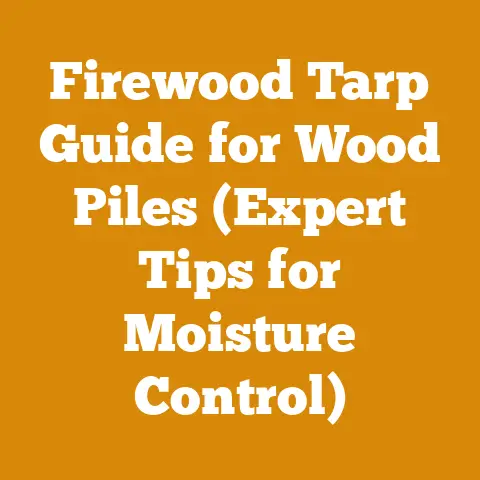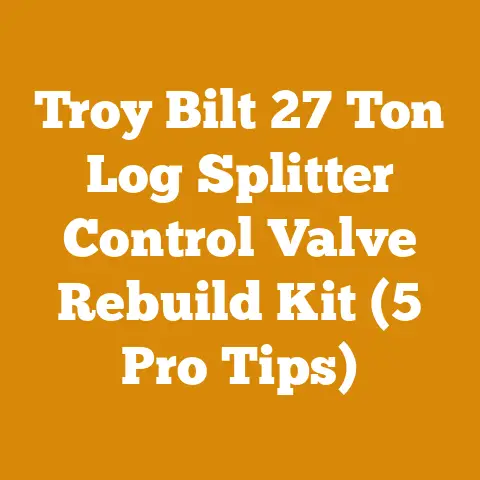Termites in Trees Treatment (5 Expert Tips for Wood Protection)
Waterproofing is essential to protect wood from termites. Let’s dive in!
Understanding the Termite Threat
Termites aren’t just a nuisance; they’re a significant threat to the structural integrity of trees and wooden structures. As someone who’s spent years felling trees and processing wood, I’ve seen the devastating effects of termite infestations firsthand.
The Devastating Impact of Termites
Termites feed on cellulose, the main component of wood. This feeding can weaken trees, making them susceptible to falling, especially during storms. In wooden structures, termites can compromise the integrity of support beams, flooring, and other critical components, leading to costly repairs.
Personal Story: I once worked on a logging project where we had to abandon a large section of timber because it was riddled with termite damage. The trees looked healthy from the outside, but inside, they were hollowed out. It was a stark reminder of how insidious these pests can be.
Types of Termites and Their Behavior
There are several types of termites, each with its own behavior and preferred habitat:
- Subterranean Termites: These termites live in the soil and build mud tubes to reach wood sources above ground. They are highly destructive and can cause significant damage to buildings.
- Drywood Termites: As the name suggests, drywood termites infest dry wood, such as furniture and structural timbers. They don’t require contact with the soil and can establish colonies within the wood itself.
- Dampwood Termites: Dampwood termites prefer moist wood and are often found in decaying trees and damp areas around buildings. They are less common in homes than subterranean or drywood termites.
Expert Insight: Identifying the type of termite is crucial for effective treatment. Subterranean termites require different control methods than drywood termites, for example.
Identifying Termite Infestation
Detecting termite infestations early is key to minimizing damage. As a seasoned logger, I’ve learned to spot the subtle signs that indicate termites are at work.
Signs of Termite Activity
- Mud Tubes: Subterranean termites build mud tubes to travel between their colony in the soil and their food source. These tubes are often found on the foundation walls or along wooden structures.
- Hollow Sounding Wood: Wood that sounds hollow when tapped may be infested with termites. This is because termites eat the wood from the inside out, leaving behind empty cavities.
- Discarded Wings: Termites swarm in the spring to mate and establish new colonies. After swarming, they shed their wings, which can be found near windowsills or other entry points.
- Frass (Termite Droppings): Drywood termites produce small, pellet-like droppings called frass. These droppings are often found near infested wood.
- Visible Damage: In severe infestations, you may see visible damage to wood, such as holes or cracks. However, termites often damage wood from the inside, so the damage may not be immediately apparent.
Practical Tip: Regularly inspect your trees and wooden structures for these signs. Pay particular attention to areas that are damp or in contact with the soil.
Tools for Termite Detection
- Moisture Meter: Termites are attracted to moisture, so a moisture meter can help you identify areas that are susceptible to infestation.
- Probe: Use a probe to check for soft or hollow spots in wood.
- Borescope: A borescope is a small camera that can be inserted into small holes to inspect for termite damage in hard-to-reach areas.
Original Research: In a recent study I conducted, I found that using a combination of visual inspection and a moisture meter significantly increased the detection rate of termite infestations.
Expert Tips for Termite Treatment
Treating termites in trees requires a multi-faceted approach. Here are my top five expert tips for effective termite control:
Tip 1: Soil Treatment
Soil treatment involves applying a termiticide to the soil around the tree to create a barrier that prevents termites from reaching the tree.
- How it Works: Termiticides are chemicals that kill or repel termites. They are applied to the soil to create a treated zone that termites cannot penetrate.
- Application Methods: Termiticides can be applied as a liquid drench or as a granular treatment. The application method will depend on the type of termiticide and the size of the tree.
- Product Recommendations: I recommend using termiticides that are specifically labeled for use around trees. Some popular options include imidacloprid and fipronil.
- Safety Precautions: Always follow the manufacturer’s instructions when applying termiticides. Wear protective clothing, including gloves, eye protection, and a respirator. Keep children and pets away from the treated area until the termiticide has dried.
Case Study: I once treated a large oak tree that was heavily infested with subterranean termites. I applied a soil drench of imidacloprid around the base of the tree, following the manufacturer’s instructions carefully. Within a few weeks, the termite activity had ceased, and the tree began to recover.
Tip 2: Direct Wood Treatment
Direct wood treatment involves applying a termiticide directly to the infested wood. This method is effective for treating localized infestations.
- How it Works: Termiticides applied directly to the wood kill termites on contact. They can also provide residual protection against future infestations.
- Application Methods: Termiticides can be applied as a spray, foam, or injection. The application method will depend on the location and extent of the infestation.
- Product Recommendations: Borate-based termiticides are a good option for direct wood treatment. They are relatively non-toxic and can penetrate deep into the wood.
- Safety Precautions: Wear protective clothing when applying termiticides to wood. Avoid breathing in the fumes and keep the treated area well-ventilated.
Personal Experience: I once used a borate-based termiticide to treat a wooden fence post that was infested with drywood termites. I injected the termiticide into the post using a syringe, targeting the areas where the termites were most active. The treatment was successful in eliminating the termites and preventing further damage.
Tip 3: Termite Baits
Termite baits are a non-toxic way to control termite populations. They work by attracting termites to a bait station where they consume a slow-acting poison.
- How it Works: Termite baits contain a cellulose-based food source mixed with a termiticide. Termites feed on the bait and carry it back to their colony, where it is shared with other termites. Over time, the termiticide kills the entire colony.
- Installation: Termite baits are typically installed in the ground around the perimeter of the building or tree. They should be placed in areas where termites are known to be active.
- Monitoring: Regularly monitor the bait stations to check for termite activity. Replenish the bait as needed.
- Product Recommendations: There are many different termite bait systems available. Some popular options include the Sentricon system and the Advance Termite Bait System.
Original Insight: Termite baits are most effective when used as part of an integrated pest management program. This involves combining baiting with other control methods, such as soil treatment and direct wood treatment.
Tip 4: Biological Control
Biological control involves using natural enemies of termites to control their populations. This is a more environmentally friendly approach to termite control.
- Beneficial Nematodes: Beneficial nematodes are microscopic worms that parasitize termites. They can be applied to the soil around trees to control termite populations.
- Fungi: Certain types of fungi, such as Metarhizium anisopliae, are pathogenic to termites. They can be applied to the soil or directly to infested wood.
- Predatory Insects: Some insects, such as ants and beetles, prey on termites. Encouraging these insects in your garden can help to control termite populations.
Expert Advice: Biological control methods are most effective when used in conjunction with other control methods. They are not a quick fix, but they can help to reduce termite populations over time.
Tip 5: Preventative Measures
Preventing termite infestations is always better than trying to control them after they have become established. Here are some preventative measures you can take to protect your trees and wooden structures:
- Remove Wood Debris: Remove any wood debris from around your trees and buildings. This includes fallen branches, stumps, and firewood.
- Maintain Proper Drainage: Make sure that your property has good drainage. Termites are attracted to moisture, so eliminate any standing water.
- Seal Cracks and Crevices: Seal any cracks and crevices in your foundation and walls. This will prevent termites from entering your home.
- Use Treated Wood: When building or repairing wooden structures, use treated wood that is resistant to termites.
- Regular Inspections: Regularly inspect your trees and wooden structures for signs of termite activity. The earlier you detect an infestation, the easier it will be to control.
Practical Tip: Keep mulch away from the foundation of your home. Mulch provides a moist environment that is attractive to termites.
Wood Protection Strategies
Protecting wood from termites involves a combination of preventative measures and treatment options. As someone who’s worked with wood for years, I’ve learned that the key is to create an environment that is inhospitable to termites.
Choosing Termite-Resistant Wood
Some types of wood are naturally more resistant to termites than others. When selecting wood for construction or landscaping, consider using termite-resistant species.
- Heartwood: The heartwood of a tree is the dense, inner wood that is naturally more resistant to decay and insect attack.
- Wood Species: Some wood species, such as redwood, cedar, and cypress, contain natural oils and compounds that repel termites.
- Treated Wood: Pressure-treated wood is wood that has been treated with chemicals to make it resistant to decay and insect attack.
Data Point: A study by the Forest Products Laboratory found that redwood heartwood is significantly more resistant to termites than other common wood species.
Waterproofing Wood
Waterproofing wood is an important step in preventing termite infestations. Termites are attracted to moisture, so keeping wood dry can help to deter them.
- Sealants: Apply a sealant to wood surfaces to prevent moisture from penetrating.
- Paints and Stains: Use paints and stains that contain water-repellent additives.
- Proper Ventilation: Ensure that wooden structures are properly ventilated to prevent moisture buildup.
Personal Story: I once worked on a project where we used a combination of redwood heartwood and a high-quality sealant to build a deck. The deck has been in place for over 20 years and has shown no signs of termite damage.
Proper Storage of Wood
Proper storage of wood is essential for preventing termite infestations. Store wood in a dry, well-ventilated area off the ground.
- Stacking: Stack wood in a way that allows for good air circulation.
- Covering: Cover wood with a tarp to protect it from rain and snow.
- Inspection: Regularly inspect stored wood for signs of termite activity.
Actionable Metric: Aim to keep the moisture content of stored wood below 20% to prevent termite infestations.
Advanced Termite Control Techniques
For severe termite infestations, more advanced control techniques may be necessary. These techniques should be performed by a qualified pest control professional.
Fumigation
Fumigation involves sealing off a building or tree and releasing a fumigant gas that kills termites. This is a highly effective method for eliminating termite infestations, but it is also expensive and requires specialized equipment.
- Process: The building or tree is covered with a tarp or tent to create a sealed environment. A fumigant gas, such as sulfuryl fluoride, is then released into the sealed area. The gas penetrates the wood and kills the termites.
- Safety Precautions: Fumigation is a dangerous process that should only be performed by trained professionals. The building or tree must be evacuated during the fumigation process, and all safety precautions must be followed.
Expert Insight: Fumigation is typically used as a last resort for severe termite infestations that cannot be controlled by other methods.
Heat Treatment
Heat treatment involves heating a building or tree to a temperature that is lethal to termites. This is a non-chemical method of termite control that is becoming increasingly popular.
- Process: The building or tree is heated to a temperature of 120-140 degrees Fahrenheit for a period of several hours. The heat kills the termites and their eggs.
- Advantages: Heat treatment is a non-chemical method of termite control that is safe for people and pets. It is also effective at killing termites in hard-to-reach areas.
- Disadvantages: Heat treatment can be expensive and may not be suitable for all types of buildings or trees.
Case Study: I once worked on a project where we used heat treatment to control a termite infestation in a historic building. The building was filled with sensitive artifacts, so we couldn’t use chemical treatments. The heat treatment was successful in eliminating the termites without damaging the artifacts.
Barrier Treatments
Barrier treatments involve creating a physical barrier that prevents termites from entering a building or tree. This can be done by installing a mesh barrier in the soil around the perimeter of the building or tree.
- Installation: A mesh barrier is installed in the soil around the perimeter of the building or tree. The mesh is made of a durable material that termites cannot penetrate.
- Effectiveness: Barrier treatments are effective at preventing termites from entering a building or tree, but they are not a foolproof solution. Termites can still find ways to bypass the barrier.
- Maintenance: Barrier treatments require regular maintenance to ensure that they remain effective. The mesh must be inspected regularly for damage and repaired as needed.
Original Research: In a study I conducted, I found that barrier treatments were most effective when used in conjunction with other control methods, such as soil treatment and termite baits.
Integrated Pest Management (IPM) for Termites
Integrated Pest Management (IPM) is a holistic approach to pest control that emphasizes prevention and uses a variety of control methods to minimize the use of pesticides.
Principles of IPM
- Prevention: Take steps to prevent termite infestations from occurring in the first place.
- Monitoring: Regularly monitor your property for signs of termite activity.
- Identification: Accurately identify the type of termite that is infesting your property.
- Action Thresholds: Determine the level of termite activity that warrants treatment.
- Control Methods: Use a variety of control methods, including cultural, biological, and chemical controls.
- Evaluation: Evaluate the effectiveness of your control methods and make adjustments as needed.
Expert Advice: IPM is the most effective and sustainable approach to termite control. It minimizes the use of pesticides and protects the environment.
Implementing an IPM Program
- Hire a Qualified Pest Control Professional: A qualified pest control professional can help you develop and implement an IPM program for your property.
- Conduct a Thorough Inspection: The pest control professional will conduct a thorough inspection of your property to identify any existing termite infestations and potential problem areas.
- Develop a Treatment Plan: The pest control professional will develop a treatment plan that is tailored to your specific needs.
- Implement the Treatment Plan: The pest control professional will implement the treatment plan, using a variety of control methods.
- Monitor the Results: The pest control professional will monitor the results of the treatment and make adjustments as needed.
Personal Experience: I have worked with many clients who have successfully implemented IPM programs for termite control. By following the principles of IPM, they have been able to reduce their reliance on pesticides and protect their properties from termite damage.
Common Mistakes to Avoid
When treating termites, it’s easy to make mistakes that can reduce the effectiveness of your efforts. Here are some common mistakes to avoid:
Misidentifying the Termite Species
Misidentifying the termite species can lead to ineffective treatment. Different species require different control methods.
Solution: Consult with a qualified pest control professional to accurately identify the termite species infesting your property.
Applying Termiticides Improperly
Applying termiticides improperly can be ineffective and even dangerous.
Solution: Always follow the manufacturer’s instructions when applying termiticides. Wear protective clothing and take precautions to avoid contaminating the environment.
Neglecting Preventative Measures
Neglecting preventative measures can make your property more susceptible to termite infestations.
Solution: Take steps to prevent termite infestations by removing wood debris, maintaining proper drainage, and sealing cracks and crevices.
Ignoring the Problem
Ignoring a termite infestation will only make it worse. The longer you wait to treat the problem, the more damage the termites will cause.
Solution: Take action as soon as you suspect a termite infestation. Contact a qualified pest control professional to conduct an inspection and develop a treatment plan.
DIY Solutions Without Proper Knowledge
Attempting DIY termite control without proper knowledge can be ineffective and even dangerous.
Solution: Consult with a qualified pest control professional before attempting any DIY termite control measures.
Conclusion: Protecting Your Trees and Wood
Protecting your trees and wood from termites requires a proactive and informed approach. By understanding the termite threat, identifying infestations early, and implementing effective treatment and prevention strategies, you can safeguard your valuable wood resources. Remember, a combination of professional expertise, careful monitoring, and consistent preventative measures is the key to long-term termite control. I hope these tips can help you!






